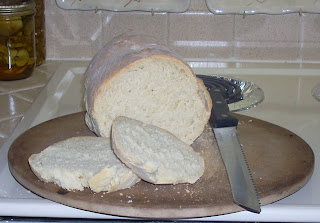Ah, How to Be a Domestic Goddess. It's gotten me into trouble before. Don't get me wrong, it's a fantastic cookbook. I've taken some of my favorite recipes from it, and I'm addicted to the way Nigella Lawson writes. When I read her recipe introductions, I can always taste just exactly how that cake or cookie or loaf of bread I'm baking will turn out.
Unfortunately, Nigella's tricky sometimes. Like any cook, her recipes don't always turn out as easily as she says they will.
This time, she convinced me to attempt my first loaf of homemade bread. Try it, she says. It's easy, she says. Everyone should do it, she says. Just mix the ingredients together, knead for a few minutes, and chuck the dough in a bowl for the night. Give it a slow, cold rise, she says.
But, alas, things didn't turn out quite so simply!
First, the dough didn't behave itself. Mixing it was difficult, much more difficult than mixing the cinnamon roll dough I made a few weeks ago. I had a hard time making the liquids combine with the dry stuff, and I was worried about soaking the dough in too much potato water, so I left it a little dry.
Then, the kneading was rough, which I'm sure was due to the dough's dryness. My muscles actually ached afterward.
The dough looked fine after kneading, though, so I threw it in our cool garage to rise overnight.
Lawson suggests that letting bread dough rise in a cold place overnight is the same as letting it rise for a couple of hours in a warm kitchen. However, when I went to check on the dough a few hours later, it was very, very puffy--it had definitely doubled and was ready to be punched down--but since I didn't want to stay up all night to bake bread, I stuck it in the refrigerator until morning.
This, I think, is where things went wrong. The dough was pretty flat again in the morning, and there was no air to punch out. Still, I had hope. I kneaded it for a bit longer than recommended and set the loaf out for 45 minutes for its second rise.
What did it do then, you ask?
Well, not much. Not much at all.
Still, I threw the loaf in the oven on my mom's old pizza stone and hoped for the best.
And, surprisingly, everything turned out okay. The crust was remarkably crisp, and the bread tasted, well, like bread is supposed to taste, only really fresh and rich and yeasty. However, the crumb was very dense, more cake-like than bread-like.
I'm still not certain of the culprit's identity. Was my bread fail due to. . .
A. a lack of moisture in the dough? Did I put in too little potato water at the beginning, which lead my little yeasty friends to die of thirst?
B. the cold rise? Does this method only work if you're a brunette British bombshell with an uncanny affinity for baked goods?
C. the dough rising too much too early? Did I shock the yeast by letting them feast and then shoving them into a cold refrigerator?
I'm leaning toward C. Are there any expert bakers out there who can help me pinpoint my problem?
Despite a so-so first attempt, I'll definitely try homemade bread again--the smell of it baking alone was worth the time and effort!--but I'll skip the cold rise next time and hope that the traditional method serves me better.
















2 comments:
Uh, no. Definitely out of my realm!
I've been making bread for years and never heard of the cold garage rise method. You may have over kneaded, can make the dough chewy...but alas! the smell of bread is worth the experimentation! congrats!
Post a Comment